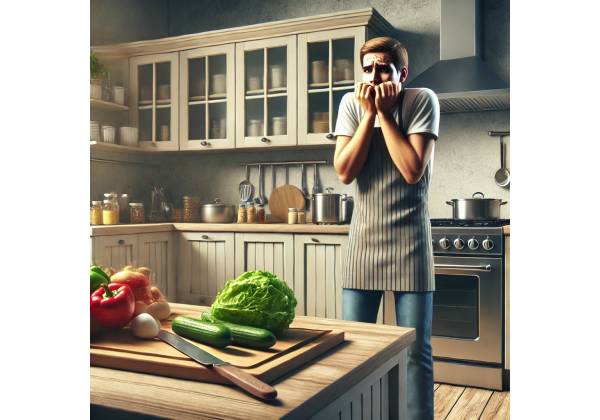What is Mageirocophobia?
Mageirocophobia is a specific phobia defined by an irrational and overwhelming fear of cooking. While many people experience anxiety or stress when preparing meals, particularly for large groups or special occasions, those with mageirocophobia experience intense fear that can disrupt daily life. This phobia is more than just a dislike of cooking; it is a persistent, often crippling fear that manifests when faced with the prospect of handling food preparation, using kitchen equipment, or preparing a meal for others.
Individuals with mageirocophobia may be excessively concerned about making mistakes, serving unsafe or inedible food, or facing criticism from others. Fear may cause avoidance behaviors, such as relying on takeout or pre-prepared meals, avoiding social gatherings that require cooking, or declining invitations to host meals. Even if they don’t need to cook right now, the mere thought of entering the kitchen can cause anxiety for some people.
This condition is frequently misunderstood because cooking is commonly regarded as a routine activity. However, for those suffering from mageirocophobia, the fear of failure or humiliation in the kitchen can be overwhelming, causing emotional and physical distress. Individuals who recognize the signs and understand the root causes can begin to address their phobia and explore treatments that help them regain control in the kitchen.
Common Symptoms of Mageirocophobia
Mageirocophobia symptoms vary in intensity and frequency, but they are generally consistent with the characteristics of specific phobias. These symptoms can be classified as physical, emotional, or behavioral manifestations. Individuals may experience symptoms while cooking, thinking about it, watching others cook, or being in a kitchen setting.
Physical Symptoms
Individuals with mageirocophobia frequently exhibit physical symptoms similar to the body’s response to anxiety or panic attacks. These responses, which are triggered by cooking-related activities or even thinking about cooking, include:
- Increased heart rate (tachycardia): One of the most common physical responses is a rapid heartbeat, which occurs when the body perceives danger.
- Shortness of breath or hyperventilation: People with mageirocophobia may find themselves breathing quickly or struggling to catch their breath, especially if the situation is overwhelming.
- Sweating or chills: Excessive sweating, especially in stressful situations like handling food or kitchen tools, is a common symptom of phobia-induced anxiety. Some people may also get chills or cold sweats.
- Shaking or trembling: The fear of making a mistake while cooking can cause shaking or trembling, especially when using kitchen utensils or interacting with food.
- Nausea or upset stomach: Cooking-related anxiety can cause gastrointestinal distress, such as nausea or stomach pain, even if no food is eaten.
- Dizziness or lightheadedness: The overwhelming anxiety associated with mageirocophobia can cause feelings of dizziness or fainting, particularly if panic attacks occur.
Emotional and cognitive symptoms
Mageirocophobia affects people on an emotional and cognitive level. Fear of cooking can have an impact on self-esteem, personal relationships, and overall mental health. Emotional symptoms include:
- Intense fear or panic: The mere thought of preparing meals can elicit intense fear, often leading to full-fledged panic attacks. This fear may seem irrational to the person experiencing it, but it remains uncontrollable.
- Embarrassment or shame: Many people with mageirocophobia are embarrassed by their inability to cook or their fear of the kitchen. This can cause shame, especially in social settings where cooking is expected.
- Feelings of inadequacy: Some people may feel inadequate or believe they are incapable of performing even basic culinary tasks. This can erode self-confidence, further entrenching the phobia over time.
- Worry about judgment: One of the most common symptoms of mageirocophobia is the fear of being judged by others. People with this condition may be extremely concerned about how their cooking will be perceived, fearing that they will serve poor food or disappoint others.
- Preoccupation with mistakes: The fear of making mistakes in the kitchen—whether it’s undercooking food, using the wrong ingredients, or burning a dish—can become a major concern. This preoccupation can lead to avoidance or procrastination when it comes to cooking.
Behavioral Symptoms
Mageirocophobia affects behavior, frequently resulting in avoidance tactics and other coping mechanisms that disrupt daily routines. Typical behavioral symptoms include:
- Avoiding cooking entirely: Many people with mageirocophobia will go to great lengths to avoid cooking, opting instead for takeout, pre-packaged meals, or eating out. They may assign cooking responsibilities to others, even if it is impractical.
- Avoidance of social situations requiring cooking: People may avoid social gatherings where they are expected to cook or bring a dish. They may decline invitations to potlucks, holiday dinners, or family gatherings.
- Reluctance to enter the kitchen: For some people, simply being in the kitchen can cause anxiety. They may avoid entering the space unless absolutely necessary, allowing others to handle food preparation and cleanup.
- Compulsive food safety behaviors: Food safety concerns, such as fears of undercooking meat, using expired ingredients, or cross-contamination, can lead to obsessive checking or overly cautious cooking techniques, extending the process and increasing stress.
- Procrastination: People may delay cooking until the last minute or find excuses to postpone meal preparation, even if they are aware that avoiding it only increases their anxiety in the long run.
The severity and variety of symptoms differ from person to person, but the persistent fear and anxiety associated with cooking is a common thread in mageirocophobia. Recognizing these symptoms is critical for seeking help and initiating treatment.
What causes Mageirocophobia?Exploring the Origins and Risk Factors
Mageirocophobia can be caused by a variety of factors, including past experiences and personality traits. Like most specific phobias, the causes are frequently multifactorial, involving both environmental and psychological components. Below are some of the most common causes and risk factors for mageirocophobia.
traumatic experiences in the kitchen
A history of traumatic cooking experiences, such as kitchen accidents, burns, food poisoning, or choking, can contribute to the development of mageirocophobia. These negative experiences may have a long-term psychological impact, making the person fearful of returning to the kitchen or preparing food.
Fear of Failure and Criticism
Many people who suffer from mageirocophobia are afraid of failure or criticism, especially in social or familial settings where cooking is considered a basic skill. The pressure to meet high standards, whether self-imposed or imposed by others, can cause extreme anxiety during meal preparation. Fear of embarrassment, being judged, or serving spoiled food can all contribute to a complete avoidance of cooking.
Perfectionism
Perfectionistic tendencies can exacerbate mageirocophobia. Those who hold themselves to unrealistic culinary perfection standards may develop a fear of cooking if they believe they will fail to meet these expectations. The pressure to prepare flawless meals can be paralyzing, resulting in avoidance behaviors or excessive stress while cooking.
Generalized Anxiety Disorder (GAD)
Individuals with generalized anxiety disorder may be more likely to develop specific phobias, such as mageirocophobia. People with GAD frequently overthink a variety of everyday activities, and cooking may become a source of anxiety for them. The fear of something going wrong in the kitchen—whether it’s an injury, a mistake, or a perceived failure—can be crippling.
Cultural or familial expectations
Cooking is considered an essential skill in some cultures or families, particularly among women. Those who are under pressure to perform well in the kitchen, whether due to cultural norms or family expectations, may develop anxiety about cooking. The fear of not meeting these expectations can develop into a phobia.
Media Influence
Television cooking shows, social media, and celebrity chefs frequently portray cooking as a high-stakes, performance-oriented activity. For some people, portraying cooking as a competitive or perfectionist endeavor can exacerbate feelings of inadequacy and anxiety, particularly if they lack skill or confidence in the kitchen.
How is Mageirocophobia diagnosed?
Mageirocophobia is typically diagnosed following a thorough assessment by a mental health professional. The process is intended to determine whether the individual’s fear of cooking is a specific phobia and to rule out other possible causes.
Clinical Interview and Symptom History
During a clinical interview, the healthcare provider will inquire about the patient’s cooking experiences and anxiety levels. The individual will most likely be asked when the fear started, how it affects their daily life, and if any previous experiences contributed to their phobia. This provides the clinician with a comprehensive understanding of the phobia’s scope and severity.
Diagnostic Criteria from DSM-5
Mageirocophobia, like other specific phobias, is diagnosed using the criteria outlined in the DSM-5. Diagnosis requires:
- Marked fear or anxiety regarding cooking or related activities.
- The fear is out of proportion to the actual dangers associated with cooking.
- The phobia causes significant distress or impairment in daily life, such as meal preparation, social interactions, or family responsibilities.
- The symptoms are persistent and typically last six months or more.
Distinguishing from Other Anxiety Disorders
While mageirocophobia has some similarities to generalized anxiety disorder (GAD) and obsessive-compulsive disorder (OCD), the fear is specific to cooking in this phobia. The mental health professional will carefully assess whether the anxiety extends beyond cooking and into other aspects of the individual’s life, or if it is limited to cooking activities. This distinction is critical for making an accurate diagnosis and developing an effective treatment plan.
Psychological Assessments
In some cases, standardized psychological tests may be used to determine the severity of the phobia. These tools assist individuals in quantifying their level of fear, anxiety, and avoidance behaviors associated with cooking. The results of these assessments can help make an accurate diagnosis and tailor the treatment plan.
Excluding Medical Conditions
Physical conditions such as hand tremors, chronic pain, or gastrointestinal issues can sometimes contribute to a person’s fear of cooking. A thorough medical history and physical examination may be performed to rule out any underlying medical issues that are exacerbating or mimicking mageirocophobia symptoms. Once a diagnosis is confirmed, the patient and their healthcare provider can collaborate to develop a comprehensive treatment plan.
Understanding Therapies and Interventions for Mageirocophobia
Mageirocophobia is treated using a variety of therapeutic interventions aimed at reducing anxiety and restoring confidence in the kitchen. The most effective treatments address both the cognitive and behavioral aspects of the phobia, allowing people to gradually overcome their fear of cooking while learning practical coping strategies. Below, we look at some evidence-based therapies and treatments for mageirocophobia.
Cognitive-Behavioral Therapy (CBT)
Cognitive behavioral therapy (CBT) is a widely used and effective treatment for phobias, including mageirocophobia. CBT helps people identify and challenge the negative thoughts and beliefs that fuel their fear of cooking. During therapy sessions, people learn to reframe their thinking, focusing on more realistic and less catastrophic outcomes.
cognitive restructuring is a critical component of CBT, in which people learn to recognize irrational fears and replace them with more balanced, rational thoughts. For example, a person with mageirocophobia may believe that they will always fail at cooking or that making a mistake in the kitchen will lead to disaster. They can learn to challenge these thoughts using CBT, understanding that mistakes are a normal part of cooking and do not reflect personal failure.
Exposure Therapy
Exposure therapy, a type of cognitive behavioral therapy, is especially effective for phobias because it involves gradual and controlled exposure to the source of the fear. For mageirocophobia, this entails gradually reintroducing the individual to cooking activities in a safe and supportive setting.
Exposure therapy starts with less intimidating tasks, like being in the kitchen without cooking, using kitchen tools, or watching others cook. As the individual gains confidence, they may progress to simpler cooking tasks, such as preparing a basic meal or using a kitchen appliance they previously avoided. Over time, repeated exposure helps the individual become desensitized to the fear and anxiety associated with cooking, making it easier to prepare meals without feeling overwhelmed.
Mindfulness-Based Stress Reduction(MBSR)
Mindfulness-based stress reduction (MBSR) can be an effective addition to other treatments for mageirocophobia. MBSR teaches people how to focus on the present moment and manage anxiety using mindfulness techniques like deep breathing, meditation, and progressive muscle relaxation.
Mindfulness practices can be especially beneficial for people suffering from mageirocophobia in terms of managing the immediate feelings of anxiety or panic that arise while cooking. Individuals who learn to observe their thoughts and emotions without judgment can reduce stress and build resilience to the phobia’s triggers.
Hypnotherapy
Hypnotherapy is another method for treating mageirocophobia. It entails guiding the person into a deeply relaxed, focused state in which they can access their subconscious mind. In this state, a hypnotherapist can work with the person to address the underlying causes of the phobia and provide positive suggestions for overcoming their fear of cooking.
While hypnotherapy is not widely used or accepted as a primary treatment for phobias, some people may find it useful as a complementary approach, particularly when combined with CBT or other forms of therapy.
Group Therapy and Support Groups
For some people, group therapy or support groups can be very helpful in dealing with mageirophobia. Individuals in a group setting can share their experiences with others who understand their difficulties, reducing feelings of isolation or shame.
Group therapy sessions frequently focus on shared experiences and coping strategies for phobias, offering both emotional support and practical advice. The sense of community and mutual understanding can be empowering for people who are trying to overcome their fear of cooking.
Practical Cooking Classes and Desensitization Workshops
Practical, hands-on cooking classes or desensitization workshops can help people with mageirocophobia gain confidence in a structured and supportive environment. These classes are frequently led by experienced instructors who can walk participants through fundamental cooking techniques in a nonjudgmental setting.
Participants may begin with simple tasks like chopping vegetables or boiling water, gradually progressing to more complex dishes as they gain confidence in the kitchen. These classes help people break down their fear of cooking into manageable steps, reducing anxiety by reinforcing the fact that cooking can be learned and enjoyed.
Medication
In some cases, medication may be used to treat mageirocophobia, particularly if the phobia is severe or accompanied by other anxiety disorders. **Selective serotonin reuptake inhibitors (SSRIs), which are commonly prescribed for anxiety disorders, can help reduce overall anxiety and make it easier for people to participate in therapy.
Benzodiazepines can also be used to treat acute anxiety symptoms like panic attacks. However, medication should be used in conjunction with therapy rather than as a standalone treatment. It is critical to discuss the potential benefits and risks of medication with a healthcare provider, especially if you are concerned about side effects or dependency.
Family and Social Support
Family and friends can also help people overcome mageirocophobia. Supportive loved ones can help progress by participating in cooking activities, praising accomplishments, and creating a nonjudgmental environment.
In some cases, family therapy may be beneficial, particularly if the fear of cooking stems from cultural or familial expectations. Addressing these dynamics in a therapeutic setting can help to reduce stress and improve communication, resulting in a healthier and more supportive environment for the individual.

















